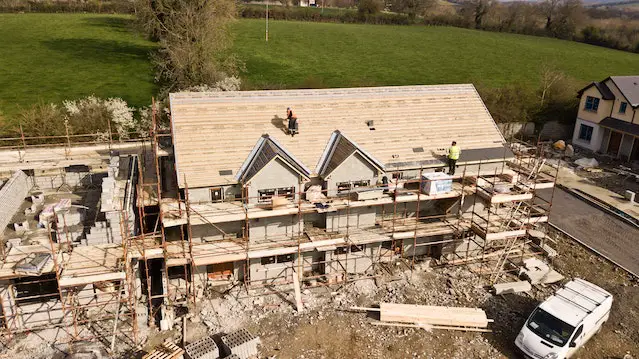Neighbour disputes are an unfortunate reality that many people face at some point in their lives. From noise complaints to property boundaries, disagreements with neighbours can cause significant stress and strain on relationships. One common source of contention between neighbours is the height of hedges. If you are wondering what is the legal height of a hedge between neighbours then keep reading.
Understanding the legal regulations surrounding hedge height is crucial to navigate such disputes effectively and maintain neighbourly relationships.
In this blog post, I will delve into the specific regulations regarding the legal height of a hedge between neighbours in the UK.
By familiarising yourself with these legal guidelines, you can ensure that your hedges are compliant and avoid potential conflicts with your neighbours.
So, let’s explore the legal framework that governs hedge height in the UK and understand the importance of abiding by these regulations.
Quick Facts About the Legal Height of a Hedge Between Neighbours
- Neighbour disputes regarding tall hedges are a common issue that can cause tension and conflicts between neighbours.
- The legal height of hedges between neighbours in the UK is primarily governed by the Anti-Social Behaviour Act 2003.
- The general rule is that hedges or trees should not exceed a height that unreasonably interferes with the enjoyment of a neighbouring property.
- Factors taken into consideration when determining the reasonableness of hedge height include light obstruction, privacy, and potential harm caused by overgrown hedges.
- Recommended guidelines suggest keeping hedges at a height of around 2 meters (6.5 feet), although specific circumstances may require adjustments.
- To make a complaint the hedge needs to be made up of a line of at least two trees or shrubs.
- Communication and cooperation with neighbours should be the first approach to address any concerns about tall hedges.
- If informal resolution fails, individuals can seek assistance from local authorities or mediation services to help find a resolution.
- Local councils may have additional rules or guidelines specific to their areas, and it’s important to check their websites or contact them directly for accurate and up-to-date information.
- Bamboo and Ivy are not included in the high hedge legislation.
Understanding the Legal Framework of High Hedges
In the United Kingdom, the legal framework governing hedge height is primarily established under the Anti-Social Behaviour Act 2003.
This legislation sets out guidelines and restrictions to prevent disputes arising from overgrown hedges that negatively impact neighbouring properties.
By having clear regulations in place, the law aims to promote peaceful coexistence and resolve potential conflicts before they escalate.
The regulations regarding hedge height serve the main aim to prevent disputes between neighbours.
Overgrown hedges can block light, obstruct views, and encroach upon neighbouring properties, causing annoyance and frustration.
By establishing legal guidelines, the intention is to ensure that hedges are maintained at a reasonable height, allowing neighbours to enjoy their properties without unnecessary hindrance.
While the Anti-Social Behaviour Act 2003 (Part 8) provides a general framework for hedge height regulations, it is important to note that local councils may have additional rules or guidelines specific to their areas.
These additional regulations can vary, and it’s essential to familiarise yourself with the specific guidelines set by your local council.
By doing so, you can ensure that you comply with both national and local regulations, promoting a smoother relationship with your neighbours and avoiding potential legal issues.

The General Rule & Legal Height of a Hedge Between Neighbours
The general rule regarding hedge height in the UK is that hedges or trees should not be allowed to grow to a height that unreasonably interferes with the enjoyment of a neighbouring property. This means that hedges should not cause significant issues such as blocking sunlight, obstructing views, or encroaching upon a neighbour’s space.
The key consideration here is striking a balance between maintaining privacy and ensuring that neighbouring properties are not unreasonably affected by the height of the hedge.
When assessing whether a hedge height is considered reasonable or not, several factors come into play.
These factors include the potential obstruction of light, impact on privacy, and the potential harm caused by overgrown hedges.
The goal is to ensure that neighbours can enjoy their properties without being unduly deprived of sunlight, having their privacy invaded, or experiencing any harm caused by neglected or overgrown hedges.
The specific circumstances of each case will be taken into consideration when determining whether a hedge’s height is within the bounds of reasonableness.
Recommended Hedge Height Guidelines
To provide further clarity and guidance on hedge height, the UK government and various organisations have put forth recommended guidelines.
These guidelines aim to help homeowners and neighbours understand what is considered acceptable in terms of hedge height.
While these guidelines are not legally binding, they can serve as a useful reference point when considering hedge maintenance.
One common guideline that is often referenced suggests keeping hedges at a height of around 2 meters (6.5 feet).
This height is considered reasonable in terms of maintaining privacy and minimising potential issues with sunlight obstruction or encroachment.
However, it’s important to note that this guideline is not a strict requirement, and the specific circumstances of each situation should be taken into account.
While the general guideline of 2 meters (6.5 feet) is often mentioned, it’s essential to recognise that certain factors may necessitate specific considerations.
The location of the hedge, its proximity to buildings, and the presence of protected species can all influence the appropriate height for a hedge.
For example, hedges near buildings may need to be kept lower to prevent damage or safety risks, while hedges in areas with protected wildlife may require special permissions or considerations.
By understanding these recommended guidelines and considering the specific factors relevant to your situation, you can ensure that your hedge height is in line with reasonable standards while taking into account the unique characteristics of your property and surroundings.
How to Resolve Hedge Neighbour Dispute
What to do if your neighbour’s hedge is too high
If you find yourself in a situation where a neighbour’s hedge exceeds the legal height or causes issues, there are steps you can take to address the problem.
The high hedge legislation was created to provide clear guidelines as to what is permitted and to so neighbours can resolve high hedge disputes without having to instruct solicitors.
It’s important to approach the matter constructively and respectfully to maintain positive relationships with your neighbours and find a resolution.
Step 1 – Talk to your neighbour
The initial step should always involve open and honest communication with your neighbour. Discuss the issue, express your concerns, and try to find a mutually agreeable solution. Often, neighbours may not be aware that their hedge is causing a problem, and a friendly conversation can lead to a resolution without the need for further action.
Step 2 – Follow up with a letter
If talking to your neighbour doesn’t help then could follow up with a letter. I have a blog on how to write a complaint letter to a neighbour that you can read here. Keep a copy of any correspondence.
Step 3 – Mediation
Mediation services can also help facilitate productive discussions and assist neighbours in finding a compromise that satisfies both parties.
Step 4 – Local Authorities
If informal resolution attempts fail or the issue persists, it may be necessary to seek assistance from local authorities. Local authorities, such as the local council or planning department, can provide guidance on the legal requirements for hedge height and may intervene if necessary (see below).
Step 5 – Legal Services
In extreme cases where all other avenues have been exhausted, legal action can be considered as a last resort. However, it’s important to note that legal proceedings should be approached with caution, as they can be time-consuming, costly, and may further strain neighbourly relationships. Before embarking on a legal route, it’s advisable to consult with legal professionals who specialise in property or neighbour disputes to understand the potential implications and determine the best course of action.
Local Council Rules and Exceptions
In addition to the general legal framework, it’s crucial to be aware that local councils may have their own specific rules or guidelines regarding hedge height.
These additional regulations can vary from one area to another, and it’s important to familiarise yourself with the specific rules applicable in your locality.
To ensure you have accurate and up-to-date information regarding hedge height regulations, it’s advisable to visit your local council’s website or contact them directly.
They can provide you with specific guidelines, exceptions, and any additional requirements that may be relevant to your area. Staying informed about local council rules will help you navigate hedge-related matters more effectively.
How to Make a Complaint about a Neighbours High Hedge
If talking to your neighbours and mediation have been unsuccessful then the next step is to make a complaint to your local council about the high hedge.
You should note that you have to evidence that you have tried to resolve the issue with your neighbour before making the complaint.
Step 1 – Contact your local council.
Step 2 – Locate the form where you can make a complaint. Make sure to add as much information as possible as this is your opportunity to make your case. You need to include how the high hedge is impacting your enjoyment of your property (such as loss of light).
Step 3 – Provide evidence that you have tried to resolve the issue directly with your neighbour. If you don’t provide this information the council will reject your application.
Step 4 – Pay the fee (this can be up as much as £650).
Step 5 – The officers will contact your neighbour and will visit the site and undertake a full investigation. They will consider both sides of the dispute.
Step 6 – If the council determine that the hedge does impact the enjoyment of your property, they will issue a formal High Hedge Remedial Notice on your neighbour.
Step 7 – If the council rejects your claim you can appeal to the independent planning inspectorate.
You can get further information on the gov.uk website.

What Happens If You Don’t Comply With a High Hedge Remedial Notice?
If a person does not comply with a High Hedge Remedial Notice issued by the local council in the UK, there can be consequences and further enforcement actions.
Here’s what may happen:
- Financial Penalties: Non-compliance with the notice can result in fines or financial penalties imposed by the local council (up to £1,000). The amount of the penalty may vary depending on the specific circumstances and local regulations.
- Enforcement Measures: The local council has the authority to take further enforcement measures to ensure compliance with the notice. This can include carrying out the necessary work to reduce the height of the hedge and charging the cost to the non-compliant party.
- Legal Proceedings: In some cases, if the non-compliance persists, the local council may initiate legal proceedings against the responsible party. This could result in court orders or injunctions compelling the necessary actions to rectify the situation.
It’s important to note that the consequences for not complying with a High Hedge Remedial Notice can vary depending on local regulations and the severity of the non-compliance.
It’s advisable to seek legal advice and engage in open communication with the local council to address any concerns or challenges related to the notice.
FAQs About Neighbour’s High Hedge
If the council conclude that your neighbour’s hedge is impacting the enjoyment of your property, then they will ask your neighbour to reduce the high of the hedge but it isn’t always under 2 meters. The council will calculate what height the hedge can be.
A High Hedge Remedial Notice is a legal notice issued by the local council in the UK to address complaints about high hedges that negatively affect the reasonable enjoyment of a neighbouring property. The notice sets out specific actions that the hedge owner must take to reduce the height or mitigate the impact of the hedge. Failure to comply with the notice can result in fines or other enforcement actions by the council.
A High Hedge Remedial Notice cannot directly enforce the removal of the hedges. Its purpose is to require the hedge owner to take specific actions to address the issues caused by the hedge, such as reducing its height or mitigating its impact.
However, if the hedge owner fails to comply with the notice, the local council may take further enforcement actions, which could potentially include the removal of the hedges. The decision to remove the hedges would typically be made by the council after considering the circumstances and potential alternatives.
Final Thoughts – What is the Legal Height of a Hedge Between Neighbours?
In conclusion, understanding ‘what is the legal height of a hedge between neighbours’ is essential to maintain good neighbourly relationships and prevent disputes.
The general rule is that hedges should not unreasonably interfere with a neighbour’s enjoyment of their property, considering factors such as light obstruction, privacy, and potential harm caused by overgrown hedges.
Recommended guidelines, although not legally binding, suggest keeping hedges at a height of around 2 meters (6.5 feet). However, it’s important to consider specific factors such as location, proximity to buildings, and protected species that may require additional considerations.
By being aware of and abiding by the legal height regulations, you can contribute to a harmonious neighbourhood environment and minimise the likelihood of disputes with your neighbours. Good communication, cooperation, and a willingness to find mutually agreeable solutions are key in addressing hedge-related issues.
If issues arise with a neighbour’s hedge, it’s crucial to engage in open communication, cooperate, and seek resolution through appropriate channels.
This can involve discussing concerns with your neighbour, seeking guidance from local authorities or mediation services, and considering legal action only as a last resort.
Remember, maintaining good neighbourly relationships is paramount, and finding amicable solutions is often the most desirable outcome.
Remember to consult with legal professionals or seek advice from relevant authorities to ensure that you have accurate and updated information specific to your situation and location.





Leave a Reply